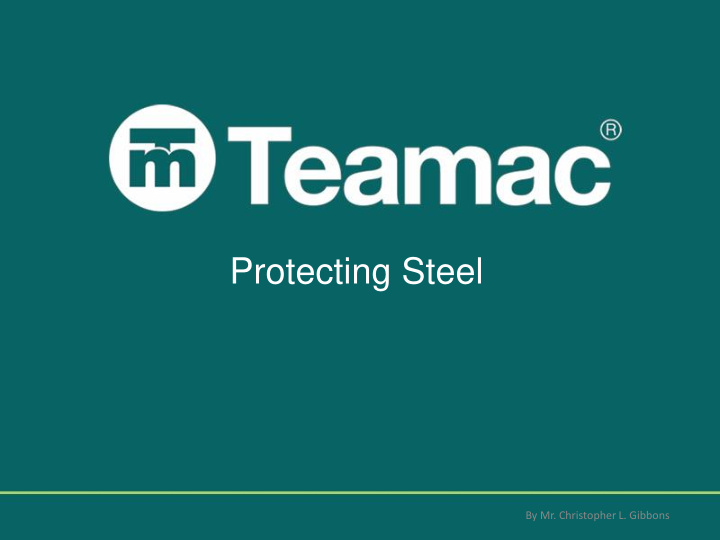



Protecting Steel By Mr. Christopher L. Gibbons
Protecting Steel Who are Teamac? 3 rd generation. Privately owned company. Based in Hull. We’ve been making paint since 1908. Who am I? Chris Gibbons. L2 Icorr Paint inspector. 40 years experience in paint application and manufacture. By Mr. Christopher L. Gibbons
Protecting Steel Why does steel rust? Steel corrosion is an Electrochemical reaction. Ions flow though an electrolyte to form a cell. Ions flow from the Anode to the Cathode. Metal depletion occurs at the anode. By Mr. Christopher L. Gibbons
Protecting Steel Why / How does steel corrode By Mr. Christopher L. Gibbons
Protecting Steel So to protect steel from the effect of the electrochemical reaction, we need to prevent a cell from forming. I.e. prevent water or other electrolytes from contacting the steel. Painting is a typical way of reducing water contact. Unfortunately all organic coatings are water permeable to a greater or lesser extent. By Mr. Christopher L. Gibbons
Protecting Steel So; we need to reduce the amount and or the reactivity of water that passes through the film. Protection is a function of film thickness, adhesion and resistance provided by additives. By Mr. Christopher L. Gibbons
Protecting Steel Prior to painting the steel needs to be “cleaned” SA2 ½ is the recommended standard for blast preparation. This will assist adhesion. By Mr. Christopher L. Gibbons
Protecting Steel 1st Coat = Usually a film containing a metal of a lower Nobility. I.e. a metal that would corrode preferentially to Iron. We now commonly use Zinc Phosphate primers. These can be single or 2 pack primer coats. Common resins are Epoxies, Alkyds, and Water based Acrylics. Their function is 3 fold. Adhesion, Passivation, and Cathodic protection of the steel. By Mr. Christopher L. Gibbons
Protecting Steel By Mr. Christopher L. Gibbons
Protecting Steel 2nd Coat or mid coat = These can be single or 2 pack film formers. Common resins are Epoxies and Alkyds. With this layer, we are trying to slow water permeation. Typically we add inorganic materials to the film former. Film thickness and cross link density also contribute to performance. Typical additives are MIO “Hematite”, or red oxide “ red rust” more modern mid coats incorporate glass plate technology. Their function is to present a “torturous path” to migrating water. By Mr. Christopher L. Gibbons
Protecting Steel 3 rd Coat = Or undercoat. Can be single or 2 pack film former. These are used to aid colour and add thickness. By Mr. Christopher L. Gibbons
Protecting Steel 3rd Coat or top coat = With this layer, we are trying to protect the sub-layers. Common resins are Polyurethane and Alkyds. Again these can be single or 2 pack top coats. These film formers are chosen for UV and or chemical protection. Aliphatic Polyurethanes are common. Normally applied in two coats. By Mr. Christopher L. Gibbons
Protecting Steel Top coat. Undercoat. Micaceous layer. Zinc rich primer layer Steel By Mr. Christopher L. Gibbons
Protecting Steel Thank you for your attention. Questions? By Mr. Christopher L. Gibbons
Recommend
More recommend